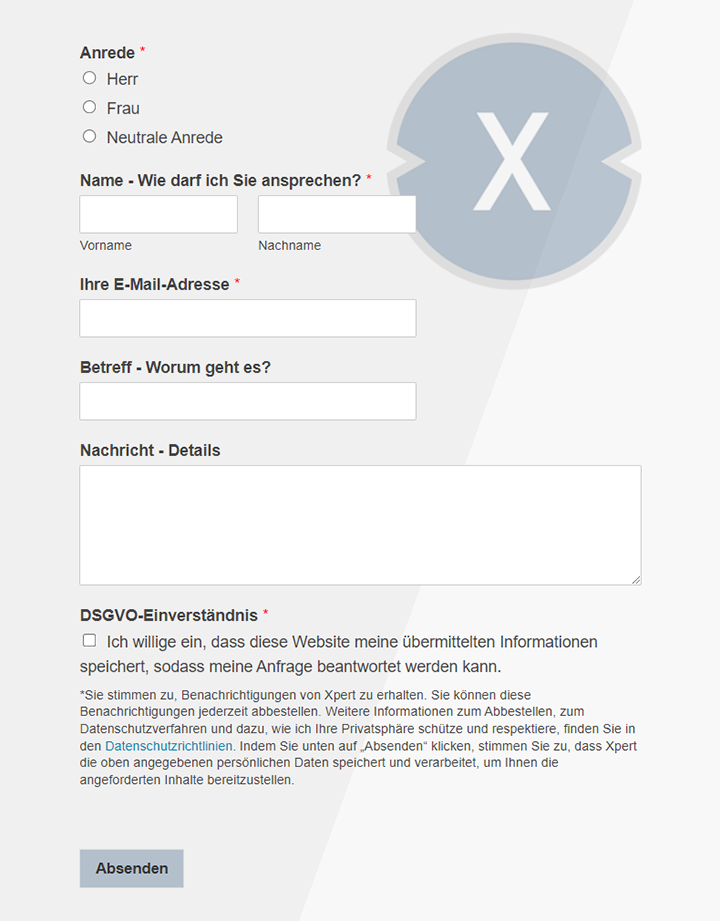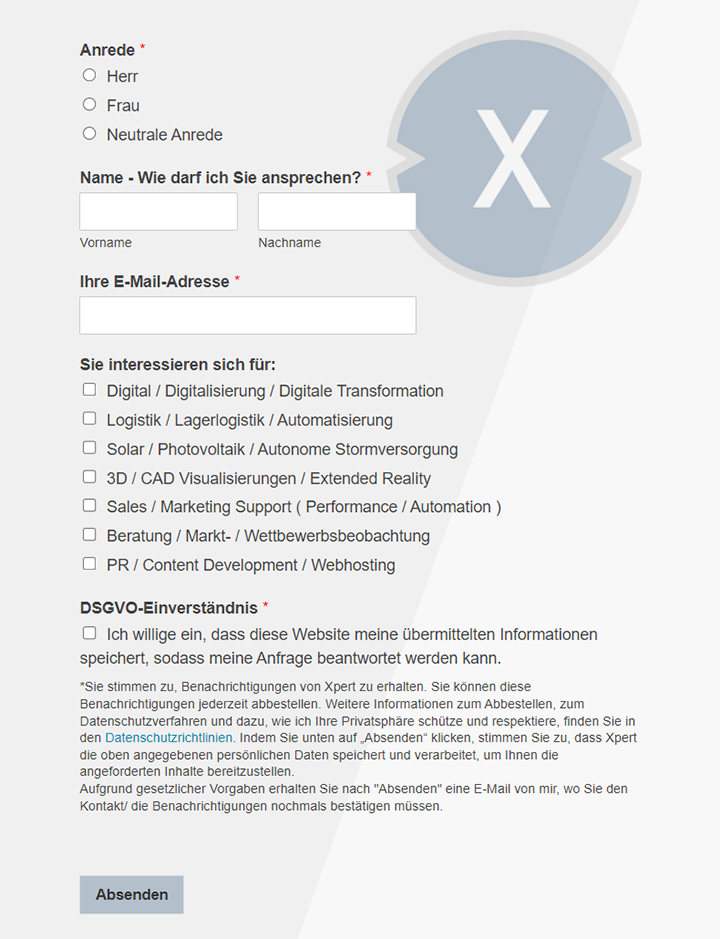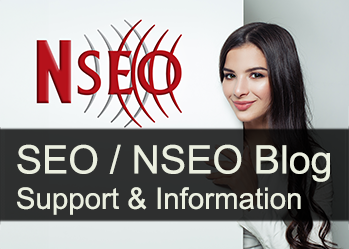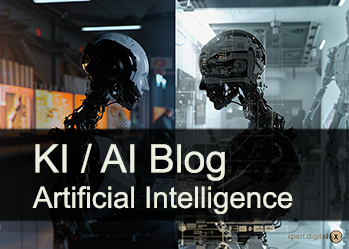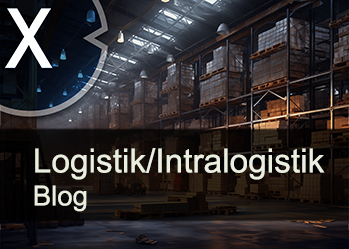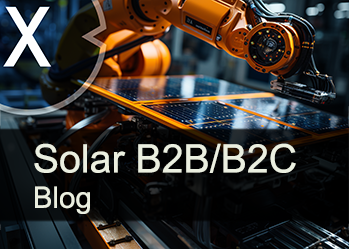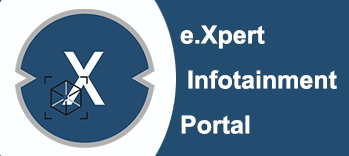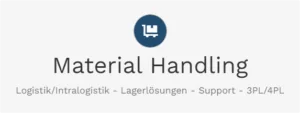Independent AI platforms as a strategic alternative for European companies
Xpert pre-release
Language selection 📢
Published on: April 15, 2025 / update from: April 16, 2025 - Author: Konrad Wolfenstein
Independent AI platforms vs. Hyperscaler: Which solution fits? (Reading time: 35 min / no advertising / no paywall)
Independent AI platforms compared to alternatives
The selection of the right platform for the development and operation of applications of artificial intelligence (AI) is a strategic decision with far -reaching consequences. Companies are faced with the choice between the offers of large hyperscales, completely internally developed solutions and so-called independent AI platforms. In order to be able to make a well -founded decision, a clear delimitation of these approaches is essential.
Suitable for:
Characterization of independent AI platforms (including sovereign/private AI concepts)
Independent AI platforms are typically provided by providers who act outside the dominant ecosystem of the Hyperscaler such as Amazon Web Services (AWS), Microsoft Azure and Google Cloud Platform (GCP). Their focus is often on the provision of specific skills for the development, deployment and management of KI and machine learning (ML) models, whereby aspects such as data control, adaptability or vertical industry integration can be emphasized more. However, these platforms can be operated on private cloud infrastructure, on-premises or, in some cases, also on the infrastructure of hyperscalers, but offer a distinct management and control layer.
A central concept that is particularly important in a European context and is often associated with independent platforms is the "sovereign AI". This term underlines the need to control data and technology. Arvato Systems, for example, differentiates between "public AI" (comparable to hyperscal approaches that potentially use user input for training) and "sovereign AI". Sovereign AI can be further differentiated:
- Self-determined sovereign AI: These are mandatory solutions that may be operated on hyperscal infrastructure, but with guaranteed EU data limits ("EU Data Boundary") or in pure EU operation. They often build on public large Language models (LLMS) that are fine-tuned for specific purposes ("Fine-Tuned"). This approach is looking for a compromise between the skills of modern AI and the necessary control over the data.
- Self -sufficient sovereign AI: This level represents maximum control. The AI models are operated locally, without dependencies on third parties, and are trained on the basis of their own data. They are often highly specialized in a certain task. This self -sufficiency maximizes control, but can potentially be at the expense of general performance or width of applicability.
In contrast to hyperscalers, which aim at width, horizontal service portfolios, independent platforms focus more frequently on specific niches, offer specialized tools, vertical solutions or position explicitly via characteristics such as data protection and data control as core benefit promises. Localmind, for example, explicitly advertises with the possibility of operating AI assistants on their own servers. The use or enabling of private cloud deployments is a common feature that gives organizations full control over data storage and processing.
Differentiation of hyperscaler platforms (AWS, Azure, Google Cloud)
Hyperscalers are large cloud providers that are the owners and operators of massive, globally distributed data centers. They offer highly scalable, standardized cloud computing resources as infrastructure-as-a-service (IAAS), platform-as-a-service (PAAS) and software-as-a-service (SaaS), including extensive services for AI and ML. The most prominent representatives include AWS, Google Cloud, Microsoft Azure, but also IBM Cloud and Alibaba Cloud.
Their main feature is the enormous horizontal scalability and a very wide portfolio of integrated services. They play a central role in many digital transformation strategies because they can provide flexible and safe infrastructure. In the AI area, hyperscales typically offer machine learning-as-a-service (MLAAS). This includes cloud -based access to data storage, computing capacity, algorithms and interfaces without the need for local installations. The offer often includes pre -trained models, tools for models (e.g. Azure AI, Google Vertex AI, AWS Sagemaker) and the necessary infrastructure for the deployment.
An essential feature is the deep integration of the AI services into the wider ecosystem of the hyperscaler (compute, storage, networking, databases). This integration can offer advantages through seamlessness, but at the same time carries the risk of strong provider dependency ("Vendor lock-in"). A critical point of distinction concerns data usage: There are consideration that hyperscal customer data - or at least metadata and usage patterns - could use to improve your own services. Sovereign and independent platforms often explicitly address these concerns. Microsoft, for example, indicates not to use customer data without consent for the training of basic models, but there are still uncertainty for many users.
Comparison with internally developed solutions (in-house)
Internally developed solutions are fully tailor-made AI platforms, which are built and managed by the internal IT or data science teams of an organization itself. In theory, they offer the maximum control over each aspect of the platform, similar to the concept of self -sufficient sovereign AI.
However, the challenges of this approach are significant. He requires significant investments in specialized personnel (data scientists, ML engineers, infrastructure experts), long development times and continuous effort for maintenance and further development. The development and scaling can be slow, which runs the risk of falling behind the rapid innovation in the AI area. If there are no extreme scale effects or very specific requirements, this approach often results in higher overall operating costs (Total Cost of Ownership, TCO) compared to the use of external platforms. There is also the risk of developing solutions that are not competitive or outdated quickly.
The boundaries between these platform types can blur. An “independent” platform can certainly be operated on the infrastructure of a hyperscaler, but offer independent added value through specific control mechanisms, features or compliance abstractions. Localmind, for example, enables operation on your own servers, but also the use of proprietary models, which implies cloud access. The decisive difference is often not only in the physical location of the hardware, but rather in the control layer (management plan), the data governance model (who controls the data and its use?) And the relationship with the provider. A platform can be functionally independent, even if it runs on AWS, AZURE or GCP infrastructure as long as it isolated the user from direct hyperscaler-lock-in is isolated and offers unique control, adjustment or compliance functions. The core of the distinction is who provides the central AI platform services, which data governance guidelines apply and how much flexibility exists outside the standardized hyperscal offers.
Comparison of the AI platform types
This tabular overview serves as the basis for the detailed analysis of the advantages and disadvantages of the various approaches in the following sections. It illustrates the fundamental differences in control, flexibility, scalability and potential dependencies.
The comparison of the AI platform types shows differences between independent AI platforms, hyperscaler AI platforms such as AWS, Azure and GCP as well as internally developed solutions. Independent AI platforms are mostly provided by specialized providers, often SMEs or niche players, while hyperscaler platforms use global cloud infrastructure providers and come from the organization developed internally. In the infrastructure, independent platforms rely on on-premises, private cloud or hybrid approaches, some of which include hyperscal infrastructures. Hyperscalers use global public cloud computing centers, while internally developed solutions are based on their own data centers or a private cloud. With regard to data control, independent platforms often offer high customer orientation and a focus on data sovereignty, while hyperscales offer potentially limited control depending on the provider guidelines. Internally developed solutions enable complete internal data control. Independent platforms are variable in the scalability model: on-premises requires planning, hosted models are often elastic. Hyperscalers offer high-grade elasticity with pay-as-you-go models, while internally developed solutions are dependent on their own infrastructure. The service width is often specialized and focused on independent platforms, but with hyperscalers, however, very broad with a comprehensive ecosystem. Internally developed solutions are tailored to specific needs. The adaptation potential is high for independent platforms, often open source-friendly, while hyperscalers offer standardized configurations within certain limits. Internally developed solutions enable the theoretically maximum adaptation potential. The cost models vary: Independent platforms often rely on license or subscription models with a mix of capex and opex, while hyperscaler primarily use opex-based pay-as-you-go models. Internally developed solutions require high capex and opex investments for development and operation. The focus on GDPR and EU compliance is often high for independent platforms and a core promise, while hyperscales are increasingly responding to it, but this can be more complex due to the US cover. In the case of solutions developed internally, this depends on the internal implementation. However, the risk of a vendor lock-in is lower for independent platforms than with hyperscalers. Hyperscalers have a high risk from their ecosystem integration. Internally developed solutions have a low vendor-block-in risk, but there is the possibility of technology block-in.
Advantage in data sovereignty and compliance in a European context
For companies that work in Europe, data protection and compliance with regulatory requirements such as the General Data Protection Regulation (GDPR) and the upcoming EU AI Act are central requirements. Independent AI platforms can offer significant advantages in this area.
Improvement of data protection and data security
An important advantage of independent platforms, especially for private or on-premises deployment, is the granular control over the location and the processing of data. This enables companies to address data localization requirements directly from the GDPR or industry -specific regulations. In a private cloud environment, the organization keeps full control over where your data is saved and how it is processed.
In addition, private or dedicated environments allow the implementation of security configurations that are tailored to the company's specific needs and risk profiles. These can possibly go beyond the generic security measures that are offered in public cloud environments by default. Even if hyperscales such as Microsoft emphasize that security and data protection “by design” are taken into account, a private environment naturally offers more direct control and configuration options. Independent platforms can also offer specific security features that are geared towards European standards, such as extended governance functions.
The limitation of data exposure to large, potentially potentially based technology groups based on the EU reduces the surface area for possible data protection injuries, unauthorized access or unintentionally continued data by the platform provider. The use of international data centers, which may not meet the security standards required by European data protection legislation, represents a risk that is reduced by controlled environments.
Fulfillment of the requirements of GDPR and European regulations
Independent or sovereign AI platforms can be designed in such a way that they inherently support the basic principles of the GDPR:
- Data minimization (Art. 5 Para. 1 lit. c GDPR): In a controlled environment, it is easier to ensure and audit that only the personal data required for the processing purpose is used.
- Percentage binding (Art. 5 Para. 1 lit. b GDPR): The enforcement of specific processing purposes and the prevention of a misuse are easier to ensure.
- Transparency (Art. 5 Para. 1 Lit. A, Art. 13, 14 GDPR): Although the traceability of AI algorithms ("Explainable AI") remains a general challenge, control over the platform makes it easier to document data flows and processing logic. This is essential for fulfilling the information obligations towards those affected and for audits. Those affected must be clearly and understandably informed about how their data is processed.
- Integrity and confidentiality (Art. 5 Para. 1 Lit. f GDPR): The implementation of suitable technical and organizational measures (TOMS) to protect data security can be controlled more directly.
- Affected rights (Chapter III GDPR): The implementation of rights such as information, correction and deletion ("right to be forgotten") can be simplified by direct control over the data.
With a view to the EU AI Act, which places risk-based requirements for AI systems, platforms are advantageous that offer transparency, control and auditable processes. This applies in particular to the use of high-risk ACI systems, as defined in areas such as education, employment, critical infrastructures or law enforcement. Independent platforms could specifically develop or offer functions to support AI ACT compliance.
Another essential point is avoiding problematic data transfer to third countries. The use of platforms that are hosted within the EU or run on premises bypasses the need for complex legal constructs (such as standard contract clauses or adequacy resolutions) for the transmission of personal data into countries without an adequate data protection level, such as the USA. Despite regulations such as the EU-US Data Privacy Framework, this remains a persistent challenge in the use of global hyperscal services.
Mechanisms to ensure compliance
Independent platforms offer different mechanisms to support compliance with data protection regulations:
- Private cloud / on-premises deployment: This is the most direct way to ensure data sovereignty and control. The organization retains physical or logical control over the infrastructure.
- Data localization / EU Boundaries: Some providers contractually guarantee that data will only be processed within the EU or specific country borders, even if the underlying infrastructure comes from a hyperscaler. Microsoft Azure, for example, offers European server locations.
- Anonymization and pseudonymization tools: Platforms can offer integrated functions for anonymization or pseudonymization of data before they flow into AI processes. This can reduce the scope of the GDPR. Federated Learning, in which models are trained locally without raw data leaving the device, is another approach.
- Compliance by Design / Privacy by Design: Platforms can be designed from scratch that they take into account data protection principles ("Privacy by Design") and offer data protection -friendly default settings ("Privacy by default"). This can be supported by automated data filtering, detailed audit logs for tracking data processing activities, granular access controls and tools for data governance and consent management.
- Certifications: Official certifications according to Art. 42 GDPR can occupy compliance with data protection standards transparently and serve as a competitive advantage. Such certificates can be sought by platform providers or more easily obtained by the user on controlled platforms. You can facilitate proof of compliance with your duties in accordance with Art. 28 GDPR, especially for processors. Established standards such as ISO 27001 are also relevant in this context.
The ability to not only achieve compliance, but also to prove it, develops from a purely need to a strategic advantage in the European market. Data protection and trustworthy AI are crucial for the trust of customers, partners and the public. Independent platforms that specifically respond to the European regulatory requirements and offer clear compliance paths (e.g. through guaranteed data localization, transparent processing steps, integrated control mechanisms), companies enable compliance risks to minimize and build trust. You can thus help transform compliance from a pure cost factor to a strategic asset, especially in sensitive industries or when processing critical data. The choice of a platform that simplifies compliance and demonstrably ensures is a strategic decision that potentially reduce the total compliance costs compared to the complex navigation in global hyperscal environments in order to achieve the same level of safety and detectability.
🎯🎯🎯 Benefit from Xpert.Digital's extensive, fivefold expertise in a comprehensive service package | R&D, XR, PR & SEM

AI & XR 3D Rendering Machine: Fivefold expertise from Xpert.Digital in a comprehensive service package, R&D XR, PR & SEM - Image: Xpert.Digital
Xpert.Digital has in-depth knowledge of various industries. This allows us to develop tailor-made strategies that are tailored precisely to the requirements and challenges of your specific market segment. By continually analyzing market trends and following industry developments, we can act with foresight and offer innovative solutions. Through the combination of experience and knowledge, we generate added value and give our customers a decisive competitive advantage.
More about it here:
Independent AI platforms: more control, less dependency
Flexibility, adaptation and control
In addition to the aspects of data sovereignty, independent AI platforms often offer a higher level of flexibility, adaptability and control compared to the standardized offers of the hyperscaler or potentially resource-intensive in-house developments.
Tailor-made AI solutions: beyond standardized offers
Independent platforms can offer more scope when configuring the development environment, the integration of specific tools of third parties or the modification of work processes than is the case with the often more standardized PAAS and SAAS services. While some modular systems, as observed in the area of AI website bubilder, prioritize speed at the expense of adaptability, other independent solutions aim to give users more control.
This flexibility enables deeper adaptation to domain -specific requirements. Companies can optimize models or entire platform setups for highly specialized tasks or industries, which can go beyond the general skills of the hyperscaler models that are often used for broad applicability. The concept of self -sufficient sovereign AI is explicitly aimed at highly specialized models trained on its own data. This flexibility underlines the possibility of transferring and adapting AI models across industries.
Another aspect is the possibility of specifically selecting and using the required components instead of having to put up with potentially overloaded or fixed service packages of large platforms. This can help to avoid unnecessary complexity and costs. Conversely, however, it must be taken into account that hyperscalers often offer a larger range of standard functions and services that are available immediately, which is examined in more detail in the section on the challenges (IX).
Suitable for:
- Artificial intelligence transforms Microsoft SharePoint with Premium AI into an intelligent content management platform
Use of open source models and technologies
A significant advantage of many independent platforms is the easier use of a wide range of AI models, especially leading open source models such as Llama (Meta) or Mistral. This is contrasting to hyperscalers who tend to prefer their own proprietary models or the models of close partners. The free model selection enables organizations to make decisions based on criteria such as performance, costs, license conditions or specific suitability for the task. Localmind, for example, explicitly supports Llama and Mistral alongside proprietary options. The European Project Opengpt-X aims to provide powerful open source alternatives such as Teuken-7b, which are specially tailored to European languages and needs.
Open source models also offer a higher level of transparency regarding their architecture and potentially also the training data (depending on the quality of the documentation, e.g. “Model Cards”). This transparency can be crucial for compliance purposes, debugging and the basic understanding of model behavior.
From the cost view, open source models, especially in the case of large-volume use, can be significantly cheaper than settlement via proprietary APIs. The comparison between Deepseek-R1 (open source-oriented) and Openai O1 (proprietary) shows significant price differences per processed token. Finally, the use of open source enables participation in the fast innovation cycles of the global AI community.
Control over infrastructure and model deployment
Independent platforms often offer greater flexibility when choosing the deployment environment. Options range from on-premises to private clouds to multi-cloud scenarios in which resources from different providers are used. Deepseek, for example, can be operated locally in Docker containers, which maximizes data control. This freedom of choice gives companies more control over aspects such as performance, latency, costs and data security.
This goes hand in hand with the possibility to optimize the underlying hardware (e.g. specific GPUs, memory solutions) and software configurations (operating systems, frameworks) for certain workloads. Instead of being limited to the standardized instance types and price models of the hyperscaler, companies can implement more potentially more efficient or cheaper setups.
Control over the development environment also enables deeper experiments and the seamless integration of custom tools or libraries that are required for specific research or development tasks.
However, the extended flexibility and control that offer independent platforms is often accompanied by increased responsibility and potentially complexity. While hyperscales abstract many infrastructure details through managed services, independent platforms, especially in the case of on-premises or heavily individualized deployments, require more internal specialist knowledge for facility, configuration, operation and maintenance. The advantage of flexibility is therefore greatest for organizations that have the necessary skills and strategic will to actively exercise this control. If this know-how is missing or the focus is primarily on fast market launch with standard applications, the simplicity of the managed hyperscal services could be more attractive. The decision depends heavily on the strategic priorities: maximum control and adaptability versus user -friendliness and width of the managed services. This compromise also affects the total operating costs (section VIII) and the potential challenges (section IX).
Reduction of Vendor Lock-in: Strategic and Effect
The dependence on a single technology provider, known as Vendor Lock-in, is a significant strategic risk, especially in the dynamic field of AI and cloud technologies. Independent AI platforms are often positioned as a means of reducing this risk.
Understanding the risks of the hyperscaler dependency
Vendor Lock-in describes a situation in which the change from the technology or the services of a provider to another is associated with a prohibitory with high costs or technical complexity. This dependence provides the provider a significant negotiating power to the customer.
The causes of lock-in are diverse. This includes proprietary technologies, interfaces (APIs) and data formats that create incompatibility with other systems. The deep integration of different services within the ecosystem of a hyperscaler makes it difficult to replace individual components. High costs for data transfer from the cloud (EGRESS COSTS) act as a financial barrier. In addition, there are investments in specific knowledge and training of employees, which is not easily transferable to other platforms, as well as long -term contracts or licensing conditions. The more services from a provider and the more they are linked, the more complex a potential change becomes.
The strategic risks of such dependency are considerable. They include reduced agility and flexibility because the company is bound to the roadmap and the technological decisions of the provider. The ability to adapt to innovative or cheaper solutions from competitors is restricted, which can slow down your own innovation speed. Companies are susceptible to price increases or unfavorable changes to the contractual conditions because their negotiating position is weakened. Regulatory requirements, especially in the financial sector, can even prescribe explicit exit strategies to manage the risks of a lock-in.
The cost implications go beyond regular operating costs. A platform change (Replatforming) causes considerable migration costs, which are reinforced by lock-in effects. This includes costs for data transfer, the potential new development or adaptation of functionalities and integrations based on proprietary technologies, as well as extensive training for employees. Indirect costs through business interruptions during migration or long -term inefficiencies with inadequate planning are added. Potential costs for exit from a cloud platform must also be taken into account.
How independent platforms promote strategic autonomy
Independent AI platforms can help to maintain strategic autonomy in different ways and reduce lock-in risks:
- Use of open standards: platforms based on open standards-for example standardized container formats (such as docker), open APIs or the support of open source models and frameworks-reduce the dependency on proprietary technologies.
- Data portability: The use of less proprietary data formats or the explicit support of data export in standard formats facilitates migration of data to other systems or providers. Standardized data formats are a key element.
- Infrastructure lexibility: The possibility of operating the platform on different infrastructures (on-premises, private cloud, potentially multi-cloud) naturally reduces the binding to the infrastructure of a single provider. Containerization of applications is mentioned as an important technique.
- Avoidance of ecosystem locks: Independent platforms tend to practice less pressure to use a variety of deeply integrated services of the same provider. This enables more more modular architecture and greater freedom of choice for individual components. The concept of sovereign AI explicitly aims to independence from individual providers.
Long-term cost advantages by avoiding lock-in
Avoiding strong provider dependence can lead to cost advantages in the long term:
- Better negotiating position: The credible opportunity to change the provider maintains the competitive pressure and strengthens your own position in price and contract negotiations. Some analyzes suggest that medium -sized or specialized providers could offer more freedom of negotiation than global hyperscals.
- Optimized expenses: Freedom to be able to select the most cost -effective components (models, infrastructure, tools) for each task enables better cost optimization. This includes the use of potentially cheaper open source options or more efficient, self-selected hardware.
- Reduced migration costs: If a change is necessary or desirable, the financial and technical hurdles are lower, which facilitates the adaptation of more recent, better or cheaper technologies.
- Foreseeable budgeting: The lower susceptibility to unexpected price increases or changes to the fee of a provider that is bound to enables more stable financial planning.
However, it is important to recognize that Vendor Lock-in is a spectrum and is not a binary quality. There is also a certain dependency when choosing an independent provider - from its specific platform functions, APIs, support quality and ultimately its economic stability. An effective strategy for reducing lock-in therefore contains more than just choosing an independent provider. It requires conscious architecture based on open standards, containerization, data portability and potentially multi-cloud approaches. Independent platforms can make it easier to implement such strategies, but do not automatically eliminate the risk. The goal should be a managed dependency in which flexibility and exit opportunities are consciously preserved instead of chasing complete independence.
Suitable for:
Neutrality in model and infrastructure selection
The choice of the optimal AI models and the underlying infrastructure is crucial for the performance and economy of AI applications. Independent platforms can offer greater neutrality here than the closely integrated ecosystems of the hyperscaler.
Avoiding ecosystem bias: Access to diverse AI models
Hyperscalers naturally have an interest in promoting and optimizing their own AI models or the models of close strategic partners (such as Microsoft with Openai or Google with Gemini) within their platforms. This can lead to these models presented preferably, better technically integrated or more attractive in terms of price than alternatives.
Independent platforms, on the other hand, often do not have the same incentive to favor a certain basic model. You can therefore enable more neutral access to a wider range of models, including leading open source options. This allows companies to align the model selection more on objective criteria such as performance for the specific task, costs, transparency or license conditions. Platforms such as Localmind demonstrate this by explicitly offering support for open source models such as Llama and Mistral alongside proprietary models such as chatt, Claude and Gemini. Initiatives such as Opengpt-X in Europe even focus on creating competitive European open source alternatives.
Objective infrastructure decisions
Neutrality often extends to the choice of infrastructure:
- Hardware-tagnosticism: Independent platforms that are operated on premises or in private clouds enable companies to select hardware (CPUs, GPUs, specialized processors, memory) based on their own benchmarks and cost-benefit analysis. They are not limited to the specified instance types, configurations and price structures of a single hyperscaler. Providers such as pure storage emphasize the importance of an optimized storage infrastructure especially for AI workloads.
- Optimized technology stack: It is possible to design an infrastructure stack (hardware, network, storage, software frameworks), which is precisely tailored to the specific requirements of AI workloads. This can potentially lead to better performance or higher cost efficiency than the use of standardized cloud modules.
- Avoiding bundled dependencies: The pressure to use specific data, network or security services of the platform provider tends to be lower. This allows a more objective selection of components based on technical requirements and performance features.
The true optimization of AI applications requires the best possible coordination of the model, data, tools and infrastructure for the respective task. The inherent ecosystem bias in the closely integrated platforms of the hyperscaler can subtly direct decisions in the direction of solutions that are comfortable, but may not be the technically or economically optimal choice, but primarily benefit the stack of the provider. With their greater neutrality, independent platforms can enable companies to make more objective, more power-oriented and potentially cost-effective decisions across the entire AI life cycle. This neutrality is not just a philosophical principle, but has practical consequences. It opens up the possibility of combining a powerful open source model with a tailor-made on-premises hardware or a specific private cloud setup-a constellation that may be difficult to realize or not promote within the “Walled Garden” of a hyperscaler. This potential for objective optimization represents a significant strategic advantage of neutrality.
Suitable for:
Seamless integration into the corporate ecosystem
The value of AI applications in the company context often only develops through integration with existing IT systems and data sources. Independent AI platforms must therefore offer robust and flexible integration skills in order to present a practical alternative to the ecosystems of the hyperscaler.
Connection to existing IT systems (ERP, CRM etc.)
The integration with core systems of the company, such as Enterprise Resource Planning (ERP) systems (e.g. SAP) and Customer Relationship Management (CRM) systems (e.g. Salesforce), is of crucial importance. This is the only way to use relevant company data for training and the use of AI and the knowledge or automation gained can be recovered directly into the business processes. For example, AI can be used to improve demand forecasts that flow directly into the ERP planning, or to enrich customer data in the CRM.
Independent platforms typically address this need through different mechanisms:
- APIS (Application Programming Interfaces): The provision of well -documented, standard -based APIs (e.g. rest) is fundamental to enable communication with other systems.
- Connectors: Prepared connectors to widespread corporate applications such as SAP, Salesforce, Microsoft Dynamics or Microsoft 365 can significantly reduce the integration effort. Providers such as Seeburger or Jitterbit specialize in integration solutions and offer certified SAP connectors that enable deep integration. SAP itself also offers its own integration platform (SAP Integration Suite, formerly CPI), which provides connectors to various systems.
- Middleware/IPAAS compatibility: The ability to work with existing company-wide Middleware solutions or integration Platform as a Service (IPAAS) offers is important for companies with established integration strategies.
- Bidirectional synchronization: For many applications, it is crucial that data can not only be read from the source systems, but can also be wrote back there (e.g. updating customer contacts or order status).
Connection to various data sources
AI models need access to relevant data, which are often distributed in a variety of systems and formats in the company: relational databases, data warehouses, data lakes, cloud storage, operational systems, but also unstructured sources such as documents or images. Independent AI platforms must therefore be able to connect to these heterogeneous data sources and process data from different types. Platforms such as Localmind emphasize that you can process unstructured texts, complex documents with pictures and diagrams as well as pictures and videos. SAPs announced Business Data Cloud also aims to standardize access to company data regardless of format or storage location.
Compatibility with development and analysis tools
Compatibility with common tools and frameworks is essential for the productivity of data science and development teams. This includes the support of widespread KI/ML frameworks such as Tensorflow or Pytorch, programming languages such as Python or Java and development environments such as Jupyter Notebooks.
Integration with business intelligence (BI) and analysis tools is also important. The results of AI models must often be visualized in dashboards or prepared for reports. Conversely, BI tools can provide data for AI analysis. The support of open standards generally facilitates the connection to a wider range of third-party tools.
While hyperscales benefit from the seamless integration within their own extensive ecosystems, independent platforms must prove their strength in the flexible connection to the existing, heterogeneous corporate landscape. Their success depends significantly on whether they can be integrated at least as effective, but ideally flexible, into established systems such as SAP and Salesforce than the offers of the hyperscaler. The “independence” of a platform could otherwise prove as a disadvantage if it leads to integration hurdles. Leading independent providers must therefore demonstrate excellence in interoperability, offer strong APIs, connectors and possibly partnerships with integration specialists. Their ability to smooth integration into complex, grown environments is a critical success factor and can even be an advantage over a hyperscal in heterogeneous landscapes, which is primarily focused on integration within its own stack.
🎯📊 Integration of an independent and cross-data source-wide AI platform 🤖🌐 for all company matters

Integration of an independent and cross-data source-wide AI platform for all company matters-Image: Xpert.digital
Ki-Gamechanger: The most flexible AI platform-tailor-made solutions that reduce costs, improve their decisions and increase efficiency
Independent AI platform: Integrates all relevant company data sources
- This AI platform interacts with all specific data sources
- From SAP, Microsoft, Jira, Confluence, Salesforce, Zoom, Dropbox and many other data management systems
- Fast AI integration: tailor-made AI solutions for companies in hours or days instead of months
- Flexible infrastructure: cloud-based or hosting in your own data center (Germany, Europe, free choice of location)
- Highest data security: Use in law firms is the safe evidence
- Use across a wide variety of company data sources
- Choice of your own or various AI models (DE, EU, USA, CN)
Challenges that our AI platform solves
- A lack of accuracy of conventional AI solutions
- Data protection and secure management of sensitive data
- High costs and complexity of individual AI development
- Lack of qualified AI
- Integration of AI into existing IT systems
More about it here:
Comprehensive cost comparison for AI platforms: Hofperscaler vs. Independent solutions
Comparative cost analysis: a TCO perspective
The costs are a decisive factor in choosing a AI platform. However, a pure consideration of list prices falls short. A comprehensive analysis of total operating costs (Total Cost of Ownership, TCO) over the entire life cycle is necessary to determine the most economical option for the specific application.
Suitable for:
Cost structures of independent platforms (development, operation, maintenance)
The cost structure of independent platforms can vary greatly, depending on the provider and the deployment model:
- Software license costs: These can be potentially lower than with proprietary hyperscal services, especially if the platform is strongly based on open source models or components. Some providers, such as scale computing in the HCI area, are positioning themselves to eliminate license costs of alternative providers (e.g. VMware).
- Infrastructure costs: In the case of on-premises or private cloud deployments, investment costs (capex) or leasing rates (opex) for servers, memory, network components and data center capacities (space, electricity, cooling) are incurred. The cooling alone can make a significant share of electricity consumption. In hosted independent platforms, subscription fees are typically incurred, which contain infrastructure costs.
- Operating costs: running costs include electricity, cooling, maintenance of the hardware and software. In addition, there are potentially higher internal personnel costs for management, monitoring and specialized know-how compared to fully managed hyperscal services. These operational costs are often overlooked in TCO calculations.
- Development and integration costs: The initial setup, integration into existing systems and any necessary adjustments can cause significant effort and thus costs.
- Scalability costs: The expansion of capacity often requires the purchase of additional hardware (nodes, servers) for on-premises solutions. These costs can be planned, but require preliminary investments or flexible leasing models.
Benchmarking based on the pricing models from Hyperscalern
Hyperscaler platforms are typically characterized by an opex-dominated model:
- Pay-as-you-go: Costs are primarily important for the actual use of computing time (CPU/GPU), storage space, data transmission and API calls. This offers high elasticity, but can lead to unpredictable and high costs with insufficient management.
- Potential hidden costs: In particular, the costs for data outflow from the cloud (EGRESS FEES) can be significant and make changes to another provider difficult, which contributes to the lock-in. Premium support, specialized or high-performance instance types and expanded security or management features often cause additional costs. The risk of transfers is real if resource use is not continuously monitored and optimized.
- Complex pricing: The pricing models of the hyperscalers are often very complex with a variety of service animals, options for reserved or spot instances and different billing units. This makes it difficult for an exact TCO calculation.
- Costs for model APIs: The use of proprietary basic models via API calls can be very expensive with a high volume. Comparisons show that open source alternatives per processed token can be significantly cheaper.
Evaluation of the costs for in -house developments
The structure of your own AI platform is usually associated with the highest initial investments. This includes costs for research and development, the acquisition of highly specialized talents and the establishment of the necessary infrastructure. In addition, there are significant running costs for maintenance, updates, security patches and the binding of the staff. Opportunity costs should also not be underestimated: resources that flow into the platform construction are not available for other value -adding activities. In addition, the time until operational capacity (time-to-market) is usually significantly longer than in the use of existing platforms.
There is no universal cheapest option. The TCO calculation is heavily context-dependent. Hyperscalers often offer lower entry costs and unsurpassed elasticity, which makes them attractive for start-ups, pilot projects or applications with a strongly fluctuating load. However, independent or private platforms can have a lower TCO in the long term in the case of predictable, large -volume workloads. This applies in particular if you take into account factors such as high data access costs for hyperscalers, costs for premium services, the potential cost advantages of open source models or the possibility of using optimized, your own hardware. Studies indicate that the TCO for public and private clouds can be theoretically similar with the same capacity; However, the actual costs depend heavily on the load, management and the specific price models. A thorough TCO analysis that includes all direct and indirect costs about the planned usage period (e.g. 3-5 years)-including infrastructure, licenses, personnel, training, migration, compliance effort and potential exit costs-is essential for a sound decision.
Total operating costs comparison framework for AI platforms
This table offers a qualitative framework for evaluating the cost profiles. The actual numbers depend heavily on the specific scenario, but the patterns illustrate the different financial implications and risks of the respective platform types.
An overall operating costs comparison framework for AI platforms shows the different cost categories and influencing factors that must be taken into account when selecting a platform. In the event of independent on-premise or private platforms, the initial investment is up to high, while it can be low to variable in hosted platforms or hyperscal-based solutions. However, internally developed solutions have very high initial costs. In the case of compute costs that affect the training and the inference, the expenses vary depending on the platform. In the case of independent platforms, these funds are, with hosted solutions and public cloud options, you can be high to potentially high-especially with a large volume. Internally developed solutions are also cost -intensive.
Facial costs are moderate in the case of independent platforms and hosted options, but often in the public cloud and pay off per gigabyte used. Internally developed solutions have high storage costs. With regard to data access or transfer, the costs for independent platforms and internal solutions are low, but can increase significantly in a public cloud environment when the data volume.
The software licensing also shows differences: While open source options keep the expenses low to medium for independent platforms, they increase in hosted or public cloud solutions, especially if platform-specific or API models are used. At the same time, lower expenses for internally developed solutions are incurred, but higher development costs. The same applies to maintenance and support - internal solutions and independent platforms are particularly cost -intensive, whereas managed services of hyperscalers have lower expenses.
The required staff and their expertise is an important factor in operating costs. Independent platforms and internally developed solutions require high competence in infrastructure and AI, while this is more moderate in hosted and public cloud options. The compliance effort varies depending on the platform depending on regulatory requirements and audit complexity. Skalability costs, on the other hand, show clear advantages for public cloud solutions because they are elastic, while they are higher in internal and on-prem solutions due to hardware and infrastructure expansion.
Exit and migration costs also play a role, especially for public cloud platforms, where there is a certain lock-in risk and can be high, whereas independent platforms and internally developed solutions in this area bring more moderate to low costs. Ultimately, the categories mentioned illustrate the financial implications and risks that should be considered when choosing a platform. The qualitative framework is used for orientation; However, the actual costs vary depending on the specific application.
Independent AI platforms offer many advantages, but also challenges that have to be taken into account. A realistic assessment of such platforms therefore requires a balanced look that includes both the positive aspects and possible hurdles.
Addressing the challenges of independent platforms
Although independent AI platforms offer attractive advantages, they are not without potential challenges. A balanced view must also take these disadvantages or hurdles into account in order to be able to make a realistic assessment.
Support, community and ecosystem maturity
The quality and availability of support can vary and may not always be able to achieve the level of global support organizations of the hyperscaler. Especially in the case of smaller or newer providers, response times or the depth of the technical know-how could be a challenge for complex problems. Even large organizations can encounter initial restrictions when introducing new AI support systems, for example in the language support or the scope of the processing.
The size of the community around a specific independent platform is often smaller than the huge developer and user communities that have formed around the services of AWS, Azure or GCP. While open source components used by the platform may have large and active communities, the specific platform community can be smaller. This can influence the availability of third-party tools, prefabricated integrations, tutorials and the general exchange of knowledge. However, it should be noted that smaller, focused communities can often be very committed and helpful.
The surrounding ecosystem - including marketplaces for extensions, certified partners and available specialists with platform skills - is generally significantly wider and lower for hyperscalers. Open source projects that independent platforms may rely on are also dependent on the activity of the community and offer no guarantee of long-term continuity.
Width and depth of the functions compared to hyperscalers
Independent platforms may not offer the sheer number of immediately available, prefabricated AI services, specialized models or complementary cloud tools that can be found on the large Hyperscaler platforms. Their focus is often on core functionalities of AI development and promotion or specific niches.
Hyperscalers invest massively in research and development and are often the first to bring new, managed AI services onto the market. Independent platforms could have a certain delay when providing the absolutely latest, highly specialized managed services. However, this is partially compensated for by the fact that they are often more flexible when integrating the latest open source developments. It is also possible that certain niche functions or country covers are not available for independent providers.
Potential implementation and management complexity
The establishment and configuration of independent platforms, especially on on-premises or private cloud deployments, can be more technically demanding and require more initial effort than the use of the often heavily abstract and preconfigured managed services of the Hyperscaler. A lack of expertise or incorrect implementation can hide risks here.
The current operation also requires internal resources or a competent partner for the management of the infrastructure, the implementation of updates, ensuring the security and monitoring of the company. This is contrary to fully managed PAAS or SAAS offers in which the provider takes on these tasks. The administration of complex, possibly on microservices based on AI architectures requires appropriate know-how.
Although, as explained in section VII, strong integration skills are possible, ensuring a smooth interaction in a heterogeneous IT landscape always harbors a certain complexity and potential sources of error. Incorrect configurations or an inadequate system infrastructure can affect reliability.
The use of independent platforms can therefore bring a higher need for specialized internal skills (AI experts, infrastructure management) as if you rely on the managed services of the hyperscaler.
Further considerations
- Provider viaility: When choosing an independent provider, in particular a smaller or newer one, a careful examination of its long-term economic stability, its product roadmap and its future prospects is important.
- Ethical risks and bias: Independent platforms, like all AI systems, are not immune to risks such as algorithmic bias (if models have been trained on distorted data), lack of explanability (especially for deep learning models-the "black box" problem) or the potential for abuse. Even if you potentially offer more transparency, these general AI risks must be taken into account when choosing a platform and implementation.
It is crucial to understand that the “challenges” of independent platforms are often the flip side of their “advantages”. The need for more internal know-how (IX.C) is directly connected to the control and adaptability obtained (IV.C). A potentially narrower initial feature set (IX.B) can correspond to a more focused, less overloaded platform (IV.A). These challenges must therefore always be assessed in the context of the strategic priorities, the risk of risk and internal abilities of the organization. A company that has a top priority for maximum control and adaptation will possibly consider the need for internal specialist knowledge as a necessary investment and not as a disadvantage. The decision for a platform is therefore not a search for a solution without disadvantages, but the selection of the platform, the specific challenges of which are acceptable or manageable in view of your own goals and resources and the best of which are best to match the corporate strategy.
Suitable for:
- Top ten AI competitors and third-party solutions as alternatives to Microsoft SharePoint Premium-Artificial Intelligence
Strategic recommendations
Choosing the right AI platform is a strategic course. Based on the analysis of the various platform types-independent platforms, hyperscal offers and in-house developments-decision criteria and recommendations can be derived, especially for companies in the European context.
Decision framework: when to choose an independent AI platform?
The decision for an independent AI platform should be considered, especially if the following factors have a high priority:
- Data sovereignty and compliance: If compliance with the GDPR, the EU AI Act or industry -specific regulations has a top priority and maximum control over data localization, processing and transparency is required (see section III).
- Avoidance of Vendor Lock-in: If strategic independence from the great hyperscalers is a central goal to maintain flexibility and minimize long-term cost risks (see section V).
- High need for adaptation: If a high level of individualization of the platform, the models or the infrastructure is required for specific application cases or for optimization (see section IV).
- Preference for open source: When specific open source models or technologies are preferred from cost, transparency, performance or license reasons (see section IV.B).
- Optimized TCO for predictable loads: When long-term total operating costs for stable, large-volume workloads are in the foreground and analyzes show that an independent approach (on-prem/private) is cheaper than permanent hyperscal use (see section VIII).
- Flexible integration into heterogeneous landscapes: If the seamless integration into a complex, existing IT landscape with systems from different providers requires specific flexibility (see section VII).
- Neutrality in the event of a component selection: If the objective selection of the best models and infrastructure components, free of ecosystem bias, is crucial for performance and cost optimization (see section VI).
Reservation in the choice of an independent platform is required if:
- Comprehensive managed services are required and internal know-how for AI or infrastructure management is limited.
- The immediate availability of the absolutely broadest range of prefabricated AI services is decisive.
- The minimization of the initial costs and maximum elasticity for strongly variable or unpredictable workloads have priority.
- There are significant concerns about economic stability, support quality or the community size of a specific independent provider.
Key considerations for European companies
There are specific recommendations for companies in Europe:
- Prioritize the regulatory environment: The requirements of the GDPR, the EU AI Act and potential national or sectoral regulations must be the focus of the platform evaluation. Data sovereignty should be a primary decision -making factor. It should be searched for platforms that offer clear and demonstrable compliance paths.
- Check European initiatives and providers: Initiatives such as GAIA-X or Opengpt-X as well as providers who explicitly concentrate on the European market and its needs (e.g. some of the in mentioned or similar) should be evaluated. You could offer better agreement with local requirements and values.
- Rate the availability of specialists: The availability of personnel with the necessary skills to manage and use the selected platform must be realistically assessed.
- Strategic partnerships are received: Cooperation with independent providers, system integrators or consultants who understand the European context and have experience with the relevant technologies and regulations can be critical of success.
Europe's AI platforms: strategic autonomy through confident technologies
The landscape of the AI platforms is developing rapidly. The following trends are emerging:
- Increasing sovereign and hybrid solutions: the demand for platforms that ensure data sovereignty and enable flexible hybrid cloud models (combination of on-premises/private cloud control with public cloud flexibility) will probably continue to rise.
- Growing importance of open source: Open source models and platforms will play an increasingly important role. They drive innovations forward, promote transparency and offer alternatives to reduce Vendor Lock-in.
- Focus on responsible AI: aspects such as compliance, ethics, transparency, fairness and the reduction of bias become decisive differentiation features for AI platforms and applications.
- Integration remains crucial: The ability to seamless integration of AI into existing company processes and systems will remain a basic requirement for the implementation of the full business value.
In summary, it can be stated that independent AI platforms represent a convincing alternative for European companies that face strict regulatory requirements and strive for strategic autonomy. Their strengths lie particularly in improved data control, the greater flexibility and adaptability as well as the reduction of Vendor lock-in risks. Even if challenges with regard to ecosystem maturity, the initial functional width and management complexity can exist, your advantages make you an essential option in the decision process for the correct AI infrastructure. Careful consideration of the specific corporate requirements, internal skills and a detailed TCO analysis are essential to make strategically and economically optimal choice.
We are there for you - advice - planning - implementation - project management
☑️ SME support in strategy, consulting, planning and implementation
☑️ Creation or realignment of the AI strategy
☑️ Pioneer Business Development
I would be happy to serve as your personal advisor.
You can contact me by filling out the contact form below or simply call me on +49 89 89 674 804 (Munich) .
I'm looking forward to our joint project.
Xpert.Digital - Konrad Wolfenstein
Xpert.Digital is a hub for industry with a focus on digitalization, mechanical engineering, logistics/intralogistics and photovoltaics.
With our 360° business development solution, we support well-known companies from new business to after sales.
Market intelligence, smarketing, marketing automation, content development, PR, mail campaigns, personalized social media and lead nurturing are part of our digital tools.
You can find out more at: www.xpert.digital - www.xpert.solar - www.xpert.plus













